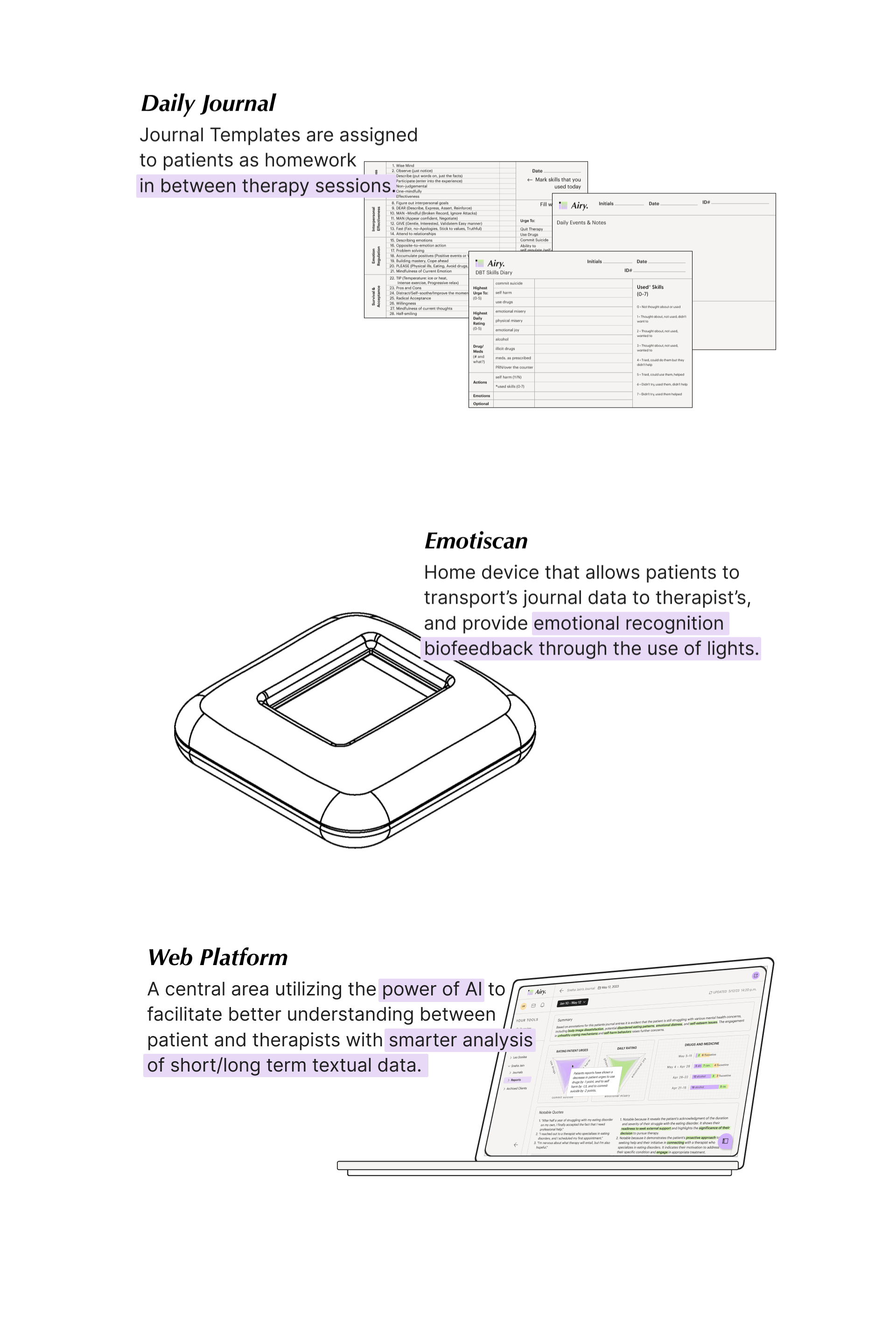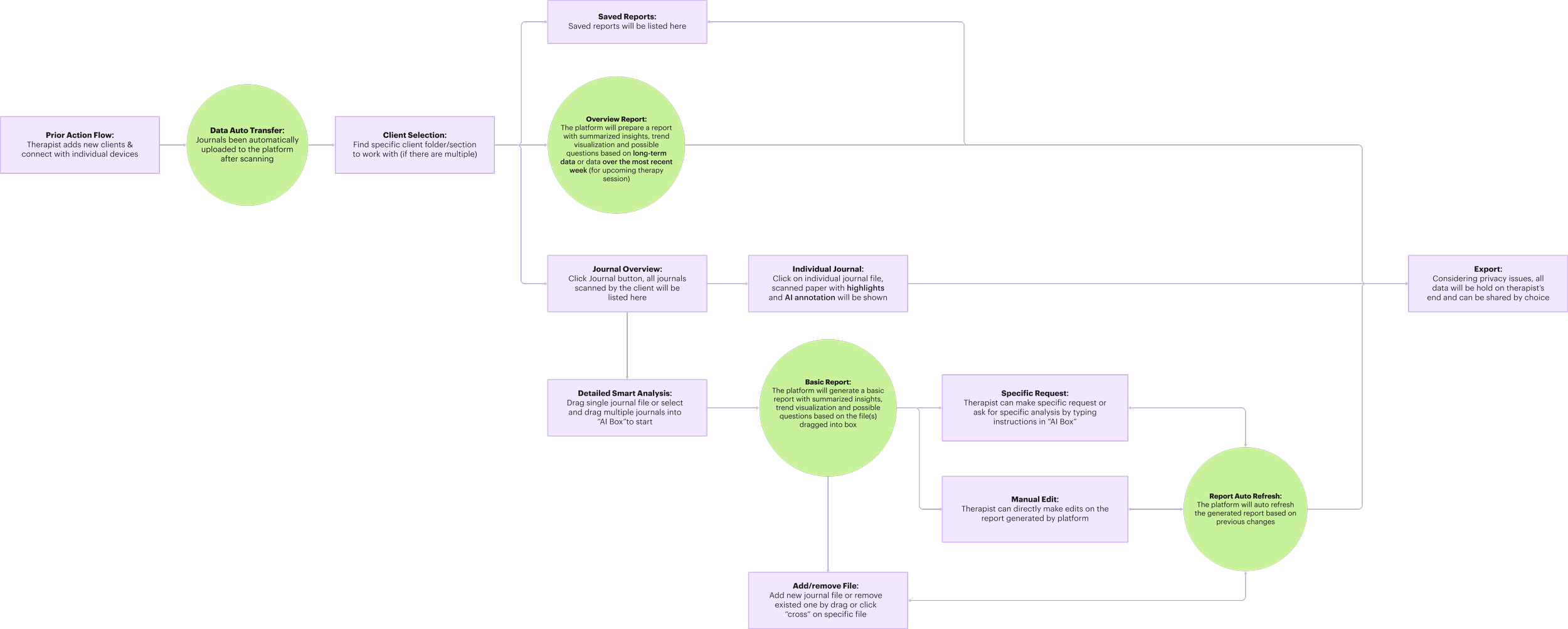Airy
Product & System Design
Team
Rannie L. / Aivy P. / Una Z.
Instructor
My Role
Project Manager / UX Research / Visual & Brand Design / Web UI&UX Design / Web Prototype
Project Info
Capstone project which exhibited in the Jacob Lawrence Gallery during the UW 2023 Design Graduation Show
Spring 2023
Project Overview
Airy is a data ecosystem including both physical and digital parts that connects journaling information to evidence-based treatment suggestions for clinical therapists to facilitate better utilization and mutual understanding during in-session moments with their clients. Within a team of three, we as designers and researchers spent 10 weeks to explore and reimagine the AI ecosystem within the mental health space.
Background
Why AI & Mental Health?
With an increasing fear of being replaced by Artificial Intelligence in workplaces among the general public, people are questioning current rapid technological innovation. To create a positive vision for the development of AI and any new technology in the future, we as a team started to explore the possibilities to utilize AI power as an efficient assist instead of any kinds of replacement.
“What if AI can be applied in clinical therapy?”
Emotions like anxiety, fear, and depression are common human reactions that can be easily triggered by long-term social pressure. There is one in five people in the US is experiencing or will experience a mental illness at any possible future moment of his/her life. However, good therapists are always hard to find and reach out. And the therapy treatment is also a long journey to take. How can we help improve the efficiency during or between each therapy session?
We thought about tackle this problem from a smaller scope: directly helping the therapists by solving one single difficulty (processing handwriting/textual data) within a specific technique (journaling) in the clinical therapy process.
How Might We
Leverage patient journaling data between sessions to facilitate better understanding between patient and therapist.
Who?
Since there are numerous products in the field to help patients with emotion regulation or digital treatment, this project is mainly designed to reduce work load and increase efficiency specifically for clinical therapists.
What?
We have chose journaling as our main treatment technique because it's a necessary process between each session and the textual data produced is the hardest to deal with for therapists..
How?
We are aiming to utilize AI power as an assistant to help recognize, analysis, and summarize textual data.
What’s Airy?
Three-part System
How it works?
The Physical Scanner
Airy Platform
The Therapist-end App
Journal Review
+ Handwriting Recognition + Notable Quotes & Analysis Generation
Journal transported from the device 'emotiscan' will be saved under Journals. The platform will provide quick annotation and/or suggestions based on the keyword extraction.
Client Profile
+ Most Recent Journal Summary + Highlights & Graphs + Smart Read
The client profile page will prepare and display the most recent week's journal data for for the upcoming therapy session. Information are summarized in highlighted texts, graphs, and numerical analysis. To avoid over-reliance or misinformation, user can hover over any data point to view the detailed explanation or reference.
Report Tool
+ Drag & Drop Comparison + Smart Analysis & Self-generation
With simple drag & drop, therapists can easily compare and contrast multiple journal files. The platform will self-generate relevant summary or suggestions.
Report Generator
+ AI Instruction Box & Conversational Edit
Based on the mental modal of ChatGPT, Airy Report Generator will take any textual instructions or requests and generate the report as therapists need.
Research Process
Initial Research for Design Focus
Secondary Research
Why AI & Clinical Therapy?
The intention of the project was to implement AI as a tool to help with clinical therapy process. Our Initial ideation was to explore the possibilities of AI as a roleplaying therapy assistance tool to help patients practice coping mechanisms in facing difficult situations. However, as we scanning through papers, articles, and discussions related to AI generating real-life situation and responses, we found that there are issues out of our scope to solve, including the unavoidable bias and ethical concerns. To ensure the more effective assistance to clinical therapy field and the maximum feasibility of the project, we turned to focus on developing tools which saving therapists time and energy for immediate use in their daily work.
Interview & Analysis
Why AI & Therapist Assist Tool?
Focused interviews were conducted to find out the pain points and design opportunities in the Cognitive Behavioral Therapy process. We have interviewed six participants including one therapist, one neuroscientist, and four patients. All of them expressed common trust issues toward accepting information directly generated, interpreted, or presented by AI, which reminded us the importance of creating an intermediary area to add more actionable human intervention points and diminish the sense of lose of control.
Insights
From therapy clients
Immediate Help: Most patients expressed needs of getting immediate help or guidance to quickly get them out of the situation when experiencing irregular emotions.
Inaccurate Memory: Patients sometimes find it difficult to recall detailed or accurate memory of what they had been through during the week in weekly sessions with therapists.
Lack of Progress: The weekly therapy session alone might not be frequent enough to help patients progress as they wish.
Insights
From therapist & neuroscientist
Human Mind Capacity: Human have limited capacity and time in processing large amount of information/data even for ones been trained.
In-between Session Support: Therapists need supportive in-between session materials (such as daily surveys or journals) to keep track with patients status/progress changes.
Evidence-based Treatment: The aim should be assisting therapists to provide evidence-based treatment to clients in flexible situations.
Design Process
Product & System Design
Scanner Research & Ideation
Ideation with Instantaneous Feedback
We had done two-weeks of research and organized three workshops to gain inspirations and ideas. In the ideation part we made it clear that the functionality of the physical part should be bridging up the communication gab between therapists and clients and aiming to provide immediate support for clients even without the presence of therapists.
Scanner Sketches & Iteration
Rapid Iteration
Different shapes, forms, and materials were tested out. The form of the physical component should fit the journal scanner task and be easy to use, non-invasive, but still interest enough to call attention.
Scanner Prototyping
Feasibility & Functionality
We finally decided to go with a round scan station to support the scan function. The hollow structure is created to hold build-in LED Strip light. We tried to apply built-in lights on the physical device with different colors and lighting patterns as indications in response to irregular mood changes in pieces of writing to help users self-regulate their emotions based on the psychological biofeedback training model.
Common Clinical Therapy Form Template
Airy Journal Template
Airy Journal Template Design
Why in daily journal form?
Journalling is a common and necessary therapy technique/assignment assigned to clients in-between sessions. We summarized the information on the most common clinical therapy journal forms and categorized the main data type into three parts: DBT coping strategy check, DBT skills evaluation, and free-written journal. The three types of information are used to track clients’ daily emotional changes as well as evaluate the progress and effectiveness of specific coping techniques assigned by therapists for clients, which allowing treatments to be adjusted in a timely manner.
Airy Visual System
Airy UI System
Airy Platform Design
Why AI & EHR Tool?
The Airy Platform mainly serves as a short/long term textual journal data processing center to help therapists analyze, summarize, and report necessary highlights and suggestions with the support of AI power. Similar with other electronic healthcare record (EHR) tools, Airy platform supports the categorization and storage of files (mostly scanned PDFs and reports) as well as the document retrieval and comparison. Instead of relying on search bar system to locate files and take actions, Airy platform utilizes conversational AI assistant to help easily interact with the system based on users’ instruction and directly deliver information in front of their eyes.
Exhibition Preparation
Final Showcase
The final product is exhibited in the University of Washington Jacob Lawrence Gallery during the UW 2023 Design Graduation Show, Spring 2023. All installations and print-out products were made within 48 hours.
Final Product & Exhibition
Airy Product, System & Additional Information




























